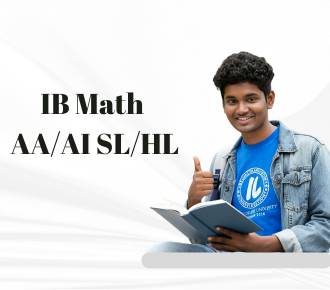- 9:30am - 6:30pm, Mon - Sun
- +91 7836034313
- R2-149 first floor M3M Cosmopolitan, sector 66 Gurugram 122102

Preparing for IB Maths – whether it’s Analysis and Approaches (AA) or Applications and Interpretation (AI) at SL or HL – can be overwhelming without a structured plan. This guide is tailored for students aiming to score well, with actionable tips, chapter prioritization, past year questions (PYQs), common mistakes, and a downloadable checklist to keep you organized throughout your preparation.
IB Maths challenges students with abstract concepts, problem-solving, and application-based questions. Without a clear roadmap, even hardworking students can lose track of what to study. By focusing on priority chapters, understanding common question patterns, and avoiding frequent mistakes, you can prepare effectively and reduce anxiety during exams.
This blog integrates advice for both IB MYP/DP maths tips, IB MYP/DP maths notes, and the IB MYP/DP maths syllabus, making it ideal for students at all levels.
IB Maths Analysis and Approaches (AA): Focuses more on algebra, functions, and theoretical mathematics. Suited for students pursuing engineering, science, or mathematics-heavy fields.
IB Maths Applications and Interpretation (AI): More practical, real-world applications, statistics, and modeling. Ideal for students interested in social sciences, business, and arts.
Standard Level (SL): Covers core topics with fewer extensions.
Higher Level (HL): In-depth topics, more challenging problems, and additional content.
Algebra and Functions
Trigonometry
Calculus
Statistics and Probability
Vectors and Matrices
Geometry
Discrete Mathematics
Complex numbers
Differential equations
Advanced integrals
Proof techniques
Download the full syllabus here.
Functions & Equations – Highly weighted in both SL and HL papers.
Calculus – Derivatives and integrals are essential; they appear in almost every exam.
Statistics – Data analysis and probability problems are common and scoring.
Vectors & Geometry – Particularly important in HL papers.
Trigonometry
Matrices
Complex numbers
Discrete mathematics
Advanced proof techniques (unless applying for HL)
Use this priority list to plan weekly targets.
Understand concepts, don’t memorize blindly.
Practice solving problems from past papers under timed conditions.
Create formula sheets and revise them daily.
Solve questions from multiple difficulty levels.
Join study groups to exchange problem-solving methods.
Read every question carefully before solving.
Allocate time based on marks (e.g., don’t spend 20 minutes on a 4-mark question).
Label all diagrams and graphs clearly.
Always double-check units and signs in final answers.
For personalized help, check out our tutors, free-trial, and pricing pages.
Skipping the theory – Not understanding why formulas work.
Poor time management – Spending too much time on early questions.
Ignoring units – Especially in statistics and probability problems.
Graphing mistakes – Mislabeling axes or failing to plot points accurately.
Neglecting calculator skills – Using incorrect modes or functions.
Copying answers without reasoning – Leads to loss of method marks.
Derivatives of trigonometric functions
Finding area under curves using integration
Standard deviation problems from data sets
Parametric equations and transformations
Matrix operations and determinants
Solve at least 3 full past papers before exams.
Review examiner reports to understand where students commonly lose marks.
Practice questions without referring to solutions first.
Access curated PYQs and sample papers here.
Create separate folders for each chapter with formulas, solved examples, and practice problems.
Use diagrams to link formulas, theorems, and problem types.
One-page summaries help during revision.
Plan weekly review sessions to keep topics fresh.
Download our ready-made IB Maths notes here.
| Time | Task |
|---|---|
| 1 hour | Solve problems from functions and calculus |
| 30 minutes | Revise theory notes |
| 30 minutes | Solve statistical problems |
| 15 minutes | Review errors made in practice |
| Weekly review | Solve one past paper |
Consistency beats intensity—practice regularly instead of cramming.
Leaving harder topics for last-minute study.
Ignoring calculator features like regression models and statistical functions.
Not writing out solutions fully (partial marks matter).
Avoiding challenging problems—practice makes perfect.
Graphing Calculators – Learn functions, regression, and plotting early.
Online Tools – Use educational apps for practice quizzes.
Collaboration Platforms – Join study forums and message boards.
Checklists & Reminders – Schedule tasks using calendar apps.
Checklist PDF includes:
✔ Weekly chapter targets
✔ Practice problem trackers
✔ PYQ review logs
✔ Formula sheets
✔ Exam day essentials
✔ Calculator tips
✔ Time management planner
Download your checklist here: Download IB Maths Checklist.
If you feel stuck or need structured guidance, explore:
Personal Tutors in Gurugram: Get in-person or online coaching.
Free Trial Sessions: Experience personalized learning strategies.
Pricing Plans: Flexible plans designed for students at all levels.
IB Maths AA/AI SL/HL is a challenge, but with the right approach, structured study, and targeted practice, you can master the syllabus and score highly. Focus on priority chapters, avoid common mistakes, and make use of available resources like tutors, notes, PYQs, and checklists.
Your journey to mastering IB Maths starts today—study smart, stay consistent, and believe in yourself.








